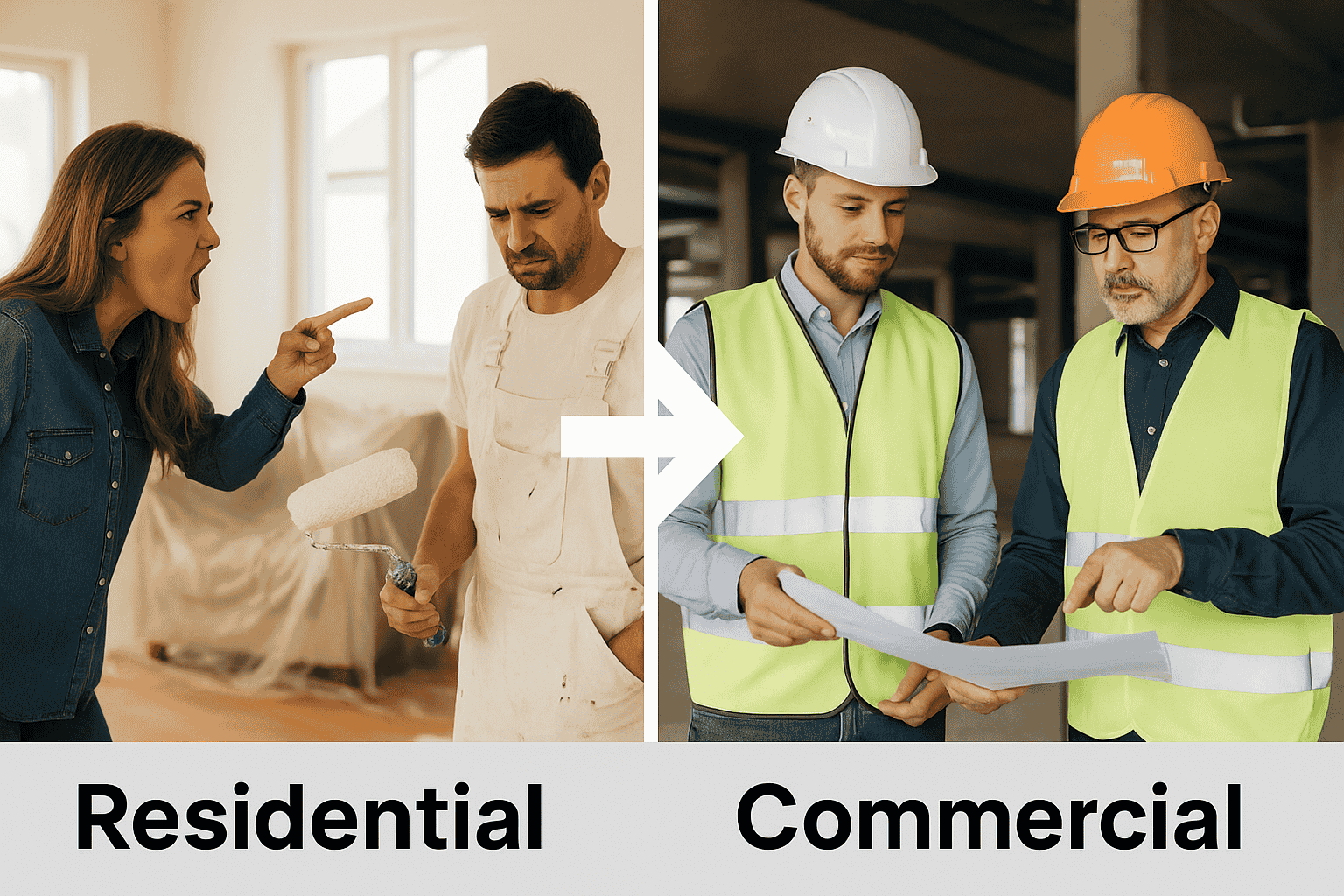From Residential to Commercial Construction, Here’s How to Make the Leap

You’ve built a solid residential business. Word-of-mouth is strong, projects are consistent, and you know how to deliver quality work that keeps homeowners happy.
But lately, you’ve been eyeing bigger jobs, ones with real budgets, repeat clients, and fewer emotional phone calls about paint colors at 10PM.
That’s where commercial construction comes in.
Shifting from residential to commercial might bring bigger checks but it’s a different game.
The sales process is longer. The buyers are less emotional. And the jobs come with more paperwork.
But if you can get past that learning curve, the upside is real: steadier work, fatter contracts, and fewer Friday-night texts from Mrs. Johnson asking if the tile grout looks “too warm.”
In this guide, we’ll break down what’s different, how to prep your business, and what it actually takes to win your first commercial project.
What’s Different Between Residential and Commercial Construction?
At some point, every good residential contractor starts wondering what it’d take to break into commercial work.
The projects are bigger. The budgets are bigger. And so are the headaches if you’re not prepared.
1. The Buyers
Residential: Homeowners. Emotional, opinionated, sometimes changing their mind mid-demo.
Commercial: Businesspeople. Focused on budget, timeline, ROI – not the “vibe” of the backsplash.
2. The Sales Process
Residential: A few referrals, a walkthrough, maybe a handshake deal.
Commercial: RFPs, bidding, estimating software, pre-con meetings, contract review, and lots of follow-up.
3. Project Scope & Complexity
Residential: Usually smaller in scope with fewer stakeholders. You might work with an architect on custom builds or major renovations, but more often, you’re dealing directly with the homeowner and managing a handful of trades.
Commercial: Bigger scopes, tighter tolerances, and way more coordination. You’re working with project managers, architects, engineers, inspectors and everyone’s got opinions. Although some projects like multi-family renovations are not as complex.
4. Permits, Code, and Paperwork
Residential: Still a hassle, but you’ve probably got it dialed.
Commercial: More regulated, more specific, and more documentation.
5. Margins, Risk, and Pay Terms
Residential: Faster payouts, more control over when you get paid.
Commercial: Bigger jobs = bigger checks but net-30 (or 60) is the norm, and lien rights get more complex. Managing cashflow becomes a bigger part of the job.
6. Quality vs. Efficiency
Residential: Quality and craftsmanship are front and center. These homeowners are staring at your work every damn day.
Commercial: Efficiency, cost control, and speed matter more than the hand-mitered trim. You still need to do good work but the KPIs shift from “is it beautiful?” to “is it done on time?”

7. Relationships Matter More Than You Think
Residential: Most jobs are one-and-done. You do the kitchen or the addition, maybe you get a call back for a small repair down the line—but that’s about it.
Commercial: You’re often working with property managers, developers, or facility teams who handle multiple buildings and ongoing projects. If they like working with you, they’ll keep you in the rotation. One good relationship can turn into steady work.
It’s not just about bidding low, it’s about being reliable, easy to work with, and showing up like a pro.
How to Get Started in Commercial Construction
So you’re ready to make the jump. Here’s how to start setting your business up for commercial work before you even land that first job.
1. Pick a Niche
Commercial is broad – office TI, hospitality, retail, medical, light industrial, multifamily, and more.
Choose a lane that aligns with your experience or goals.
Pro tip: Multifamily is often a smoother transition from residential since the work (framing, drywall, finishes) feels familiar, just at a larger scale.
2. Get the Right Paperwork in Place
Commercial clients will expect to see proof of insurance, bonding capacity, and any licenses or certifications you need in your market. You don’t want to be scrambling when you get your shot.
Most companies require you to onboard as a vendor before you can start bidding on jobs so you will need most of this upfront.
3. Upgrade Your Branding
If your website screams “kitchen remodels and man caves,” it’s time for a refresh. Make sure you look the part.
Add commercial sections to your website and start to build up your commercial project portfolio
Commercial clients want to see clean branding, professional project photos, and a sense that you know how to handle their type of work.
4. Build a Portfolio, Even if It’s Small
You don’t need a $10M high-rise on your resume to get started.
A polished, well-run tenant improvement project or a small retail buildout is enough to show that you can deliver.Your going to need to work your way up anyway.
Lean on your team or partners with they have more experience then you do. You can advertise their projects if they are going to be involved.
If you don’t have pictures, a project resume or “list of notable projects” will suffice. This is one of the first things that potential clients will ask for.
5. Start Building Relationships
Commercial work is often awarded through relationships – not Craigslist leads. Start reaching out to property managers, small developers, brokers, and local business owners in your network. Let people know you’re expanding into commercial.
Okay, but what if I have zero commercial experience?
Good question. Here’s the honest truth: everyone starts somewhere. And there are smart ways to break in even without a track record.
Start Small
Target projects that are commercial in category but residential in feel. Think:
- Local restaurants
- Small retail buildouts
- Office renovations
- Multifamily units
These jobs are often managed by individual owners or small groups not huge corporate teams with strict prequalification requirements.
Focus on Local, Not Corporate
If you want to get into hospitality construction, don’t start with Hilton. Start with the local coffee shop that’s opening a second location. These owners care more about trust, responsiveness, and price than your commercial resume.
Partner With Experience
Team up with a PM, estimator, or superintendent who has commercial experience. You can lean on their background, learn from them, and leverage their resume to give clients more confidence. Yes, you’ll split the profit but it’s worth it if it gets you in the game.

Be Competitive on the First Few Jobs
You might not hit a home run on Job #1, and that’s okay. You’re asking someone to take a risk on you being sharp, responsive, and fair on pricing is part of the trade. Nail the job, and the next one gets easier.
How to Win Your First Commercial Job
You’ve picked a niche, got your paperwork in order, and maybe even brushed up your website. Now comes the fun part—actually landing your first commercial job.
Here’s how to make it happen:
1. Start with Warm Leads
Before you start cold-calling developers, think about who’s already in your network.
- Know any trades who work commercial jobs? Ask who they build for.
- Got a buddy who opened a new gym, restaurant, or office? Offer to help with their next project.
- Reach out to residential clients who own commercial property. You’d be surprised how many do.
Word-of-mouth still works – it’s just different people now.
2. Target Smaller Players
You’re not going to land a job with a national REIT or chain store on Day 1. Focus on:
- Small developers
- Local business owners
- Boutique property management firms
- Tenant reps and brokers with local clients
These folks are more open to working with someone new as long as you show up like a pro, give them white glove service and are competitive with your bids.
3. Go After Tenant Improvement (TI) Projects
TI work is the gateway drug to commercial construction. It’s less risky, more manageable in scope, and easier to wrap your head around than ground-up builds.
Plus, once you’ve done a few solid TIs, you’re on your way to bigger things.
4. Treat Your Bid Like a Sales Tool
Once you get your foot in the door, the bid is where you win or lose. Don’t just slap a number on a PDF and hit send. Your bid is your first real impression, it shows whether you understand the scope, the priorities, and how to communicate like a professional.
Here’s how to stand out (and not get ignored):
- Make it clean and easy to read. No typos, no sloppy formatting. Clear scope breakdown. Line items if needed. Organize it so they don’t have to hunt for what they care about.
- Include a brief project summary. Demonstrate you understand what they’re asking for. Restate the goal, timeline, and any key factors you picked up during your walkthrough or call.
- Offer value upfront. Share a design improvement idea. Suggest value engineering options to save cost or time.
- Make sure your bid is competitive.
Again: MAKE SURE YOUR BID IS COMPETITIVE.
This is your first real test of competence. If your number is way high or worse, way low, they won’t take you seriously
You’re not just submitting a number. You’re giving them a reason to trust you with their money, their timeline, and their reputation.
5. Follow Up Like a Pro
A lot of bids die because the contractor goes radio silent. Send a follow-up email. Ask if they have questions. Stay in front of them without being pushy. Consistency = trust. And once you win that first project, make sure to stay in touch for the next ones.

Conclusion: From Residential to Commercial – You’ve Got What It Takes
Breaking into commercial construction might feel like stepping into a whole new world but you already have the foundation. You know how to manage subs, deliver quality work, and keep projects moving.
The key now is learning how to sell to a different type of client, navigate a more formal bidding process, and position your business like a commercial pro.
Start small. Build smart relationships. Make your first job count.
And remember: every commercial contractor started with zero experience at some point. The ones who figured it out didn’t wait for permission, they got scrappy, stayed consistent, and earned their spot.
You’ve already proven yourself in residential. Now it’s time to take that same grit and go build something bigger.
And if you need help, contact us. We’ve helped contractors go from $0 to $1,000,000+ in commercial jobs in their first year.







